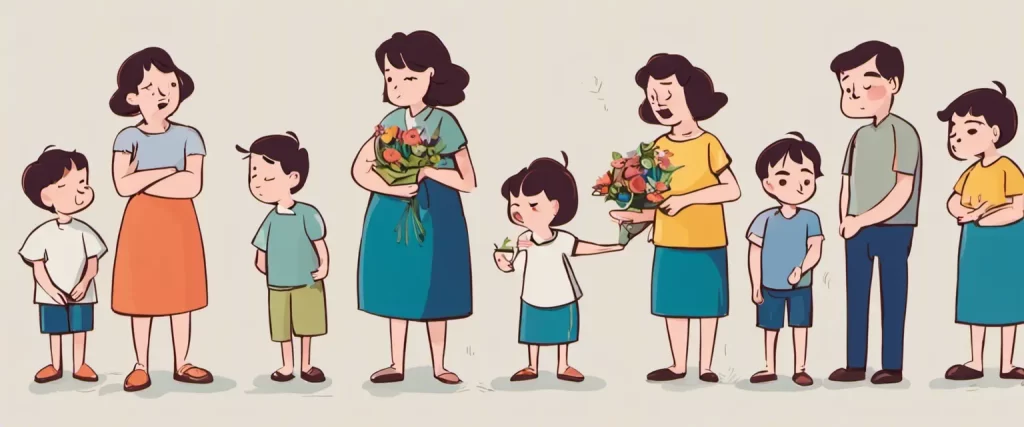——How to Talk So Kids Will Listen by Adele Faber & Positive Discipline by Jane Nelsen
In today’s fast-paced and ever-changing world, raising children has become an increasingly delicate task for parents. With the abundance of conflicting advice and techniques, finding an effective approach to communicate and discipline our little ones can often feel like navigating through a maze. Amidst this confusion, two books have emerged as beacons of hope for parents seeking to foster better connections with their children: “How to Talk So Kids Will Listen” by Adele Faber and “Positive Discipline” by Jane Nelsen.
Both books delve into the art of effective communication and discipline, recognizing the unique needs and emotional well-being of children. They offer practical insights, strategies, and techniques that empower parents to create respectful relationships with their children while encouraging them to develop skills that will serve them throughout their lives.
Adele Faber’s “How to Talk So Kids Will Listen” is a renowned classic that has withstood the test of time since its publication in 1980. Drawing on her expertise as a parent educator and communication specialist, Faber presents a revolutionary approach to talking and listening to children. She emphasizes empathetic listening, acknowledging children’s emotions, and using alternative ways to express limits and expectations in a non-confrontational manner. Faber’s book has resonated with millions of parents worldwide and continues to be a go-to resource for enhancing cooperation, defusing power struggles, and fostering a stronger bond between parents and children.
On the other hand, Jane Nelsen’s “Positive Discipline” provides an in-depth exploration of a similar philosophy from a slightly different angle. Published in 1981, Nelsen’s book focuses on instilling discipline through mutual respect, encouragement, and problem-solving. With a background in psychology and counseling, she introduces parents to the principles of positive discipline, aiming to create an environment where children can develop self-discipline and responsibility. Nelsen’s book challenges traditional punitive methods and encourages parents to emphasize connection, understanding, and guidance as a means of encouraging long-term behavioral change.
While the ultimate goals of both books align, they employ different strategies and perspectives to achieve them. “How to Talk So Kids Will Listen” leans towards building strong parent-child relationships through empathetic listening and non-directive communication techniques, while “Positive Discipline” explores the role of firm yet nurturing boundaries in shaping a child’s behavior. By examining the unique approaches outlined in each book, we can gain a comprehensive understanding of the various tools and strategies available to parents seeking to navigate the complexities of raising respectful, well-adjusted children.
As we embark on this comparative journey, we will delve into the core principles and practical applications of both books, exploring their shared philosophy while highlighting the nuances that make each approach distinctive. By illuminating the strengths and weaknesses of their respective methods, we aim to equip parents with the knowledge and insight necessary to make informed choices as they strive to create healthy, harmonious relationships with their children.
Brief Summary of Two Books
How to Talk So Kids Will Listen by Adele Faber
How to Talk So Kids Will Listen & Listen So Kids Will Talk” by Adele Faber and Elaine Mazlish is a renowned parenting manual that offers effective communication techniques for parents and caregivers to connect with children more effectively.
The book emphasizes the importance of mindful communication and understanding a child’s perspective. It introduces practical strategies and tools to navigate through various parenting challenges, such as dealing with feelings, engaging cooperation, expressing anger, discipline, and praise.
Faber and Mazlish present real-life examples, dialogues, and illustrations to demonstrate how the suggested techniques can be applied in everyday situations. They advocate active listening, empathy, and validation as vital elements in fostering respectful and open conversations with children.
The authors highlight the significance of acknowledging and validating a child’s emotions, thereby avoiding dismissive or judgmental responses. They promote problem-solving strategies that encourage children to think for themselves and take responsibility for their actions.
Throughout the book, Faber and Mazlish underline the importance of building a positive relationship with children, promoting self-esteem, and encouraging cooperation rather than discipline through punishment. They provide empowering alternatives, such as using descriptive praises to reinforce positive behavior.
The book also addresses common parent-child conflicts and offers strategies to resolve them peacefully, including developing negotiation skills and teaching children to express their needs effectively.
Overall, “How to Talk So Kids Will Listen & Listen So Kids Will Talk” serves as a practical guide for parents, aiming to enhance communication and understanding between adults and children, fostering a more harmonious and respectful family environment.
Positive Discipline by Jane Nelsen
Positive Discipline” by Jane Nelsen is a book that aims to guide parents and caregivers in raising responsible, respectful, and self-disciplined children. The book offers a comprehensive approach to discipline that focuses on long-term solutions rather than quick fixes or punishment. Nelsen introduces the concept of “positive discipline,” which emphasizes mutual respect, understanding, and cooperation between parents and children.
The book highlights the importance of encouraging the development of essential life skills, such as problem-solving, decision-making, empathy, and self-control, in children. Nelsen advocates for parenting techniques that foster a sense of belonging and significance in children’s lives. Rather than resorting to punishment or rewards, the book explains how parents can use natural consequences to teach accountability and problem-solving skills.
Nelsen also provides practical strategies for effective communication, including active listening, assertiveness, and conflict resolution. She offers guidance on how to establish family meetings, where everyone can openly discuss household issues and make decisions together. The book also addresses common parenting challenges like sibling rivalry, bedtime struggles, and power struggles, providing specific tools to handle these situations with empathy and respect.
“Positive Discipline” encourages parents to move away from traditional authoritarian or permissive parenting styles and find a balanced approach that cultivates self-discipline and respect for others. The book emphasizes the significance of mutual respect and understanding in fostering healthy parent-child relationships. Overall, Nelsen’s book offers a holistic and empowering approach to discipline that helps children develop important life skills while fostering positive and respectful family dynamics.
Comparison between Two Books

Similarities in Parent Child Communication
“Parallel: How to Talk So Kids Will Listen” by Adele Faber and “Positive Discipline” by Jane Nelsen are both highly acclaimed books that aim to provide effective strategies for parent-child communication. Although the two books have slightly different approaches, they share several similarities in their recommendations:
1. Respectful communication: Both books emphasize the importance of treating children with respect and dignity when communicating with them. They advocate for avoiding harsh language, criticism, and shaming, and instead encourage parents to use kind and respectful words.
2. Active listening: Adele Faber and Jane Nelsen both emphasize the significance of active listening and acknowledging children’s feelings. They teach parents to show empathy and understanding, and to validate their children’s emotions, which helps establish a nurturing environment for open communication.
3. Encouraging autonomy: Both authors promote the idea of allowing children to make choices and decisions based on their age and capability. They emphasize the need for parents to respect and support their children’s autonomy, thus fostering a sense of self-confidence and independence.
4. Problem-solving skills: Adele Faber and Jane Nelsen highlight the importance of teaching children problem-solving skills. They suggest involving children in finding solutions to conflicts or challenges, rather than imposing decisions on them. This approach encourages children to take responsibility for their actions and empowers them to resolve issues.
5. Non-punitive discipline: In both books, the authors advocate for using positive discipline approaches that focus on understanding the underlying reasons for misbehavior. They teach parents to avoid punitive measures or punishments that can damage the parent-child relationship, instead providing constructive guidance and setting clear boundaries.
6. Effective praise and encouragement: Both authors stress the significance of providing genuine praise and encouragement to children. They promote the idea of acknowledging children’s efforts rather than solely focusing on their achievements. This approach helps foster healthy self-esteem and motivation in children.
While these books may differ in their specific techniques and examples, they share a common goal of improving parent-child communication by emphasizing respect, active listening, problem-solving, positive discipline, autonomy, and effective praise. Parent-child communication becomes a collaborative and nurturing process, where children feel valued and understood, leading to stronger relationships and healthier development.
Divergences in Parent Child Communication
How to Talk So Kids Will Listen by Adele Faber and Positive Discipline by Jane Nelsen are both influential books that offer guidance on effective parent-child communication. While they share the common goal of improving communication and building healthy relationships between parents and children, there are some divergences in their approaches.
Divergence 1: Focus on Empathy and Understanding
How to Talk So Kids Will Listen emphasizes the importance of empathizing with children and understanding their feelings and perspectives. Adele Faber encourages parents to actively listen, acknowledge emotions, and validate their child’s experience. The book prioritizes creating an emotional connection between parents and children to foster open communication.
Positive Discipline, on the other hand, takes a slightly different approach by emphasizing understanding the underlying causes of children’s behaviors. Jane Nelsen encourages parents to focus on empathy but also aims to empower parents with effective discipline strategies. The book teaches parents to guide and teach children rather than exerting control or using punishment.
Divergence 2: Discipline Techniques
In How to Talk So Kids Will Listen, Faber promotes a problem-solving approach where both the parent and child collaborate to find solutions. Discipline is seen as an opportunity for growth and learning rather than punishment. Natural consequences and logical consequences are explored as alternatives to traditional punishment methods.
In Positive Discipline, Nelsen introduces the concept of firmness and kindness, promoting a balance between discipline and empathy. The book provides strategies such as logical consequences, time-outs, and using respectful communication to guide children’s behavior. Positive Discipline also incorporates the use of family meetings and democratic decision-making to involve children in problem-solving.
Divergence 3: Communication Tools
How to Talk So Kids Will Listen offers practical communication tools such as acknowledging feelings, describing the problem, giving choices, and engaging in active listening. It provides specific dialogue examples and step-by-step approaches to enhance understanding and create a respectful environment.
Positive Discipline provides a broader range of communication tools and techniques. With a focus on problem-solving, Jane Nelsen introduces techniques like reflective listening, validation, and effective questioning. The book also highlights the importance of non-verbal communication, body language, and tone of voice in promoting effective parent-child communication.
In conclusion, both How to Talk So Kids Will Listen and Positive Discipline share the intention of improving parent-child communication, but they employ slightly different approaches. How to Talk So Kids Will Listen focuses on empathy, understanding, and creating an emotional connection. Positive Discipline adds the element of firmness and kindness while empowering parents with effective discipline strategies. Ultimately, the choice between the two books may depend on the unique needs and parenting style of the individual reader.

Conclusion
Both “How to Talk So Kids Will Listen” by Adele Faber and “Positive Discipline” by Jane Nelsen are highly regarded books on parenting and communication with children. Both books offer valuable insights and practical tips for nurturing positive relationships and cooperation with children.
The choice of which book is more worthy of reading depends on personal preference and what resonates with you as a reader. Here are some factors to consider:
1. Writing style: Read a few pages from each book or go through their reviews to get a sense of the writing style. Pick the book that you find engaging and easy to understand.
2. Focus: “How to Talk So Kids Will Listen” primarily emphasizes effective communication strategies, including active listening, problem-solving, and understanding children’s emotions. It provides numerous real-life examples and practical exercises. On the other hand, “Positive Discipline” offers a broader approach, focusing on discipline methods that promote mutual respect, cooperation, and responsibility.
3. Compatibility with your parenting style: Consider your own parenting philosophy and style. Choose the book that aligns more closely with your values and approaches to raising children.
4. Specific challenges: If you are facing specific challenges, such as frequent power struggles or difficulties communicating with your child, check which book offers more relevant advice for those situations.
Ultimately, both books offer valuable insights, and parents often find it helpful to read and absorb ideas from various sources. You can start with either book and explore further based on your needs and interests.



